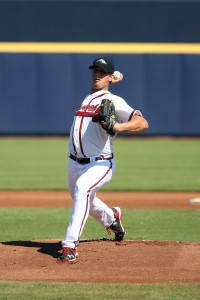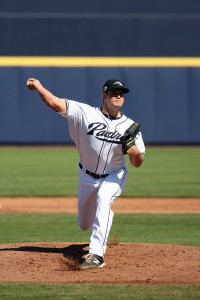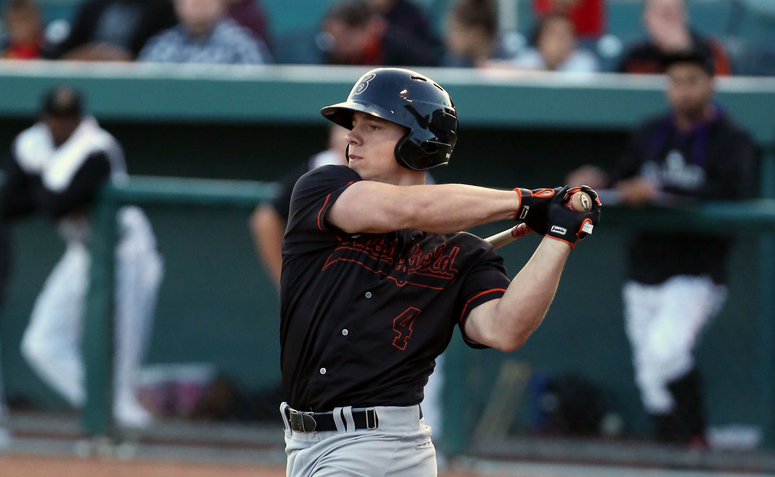
Organizational Affiliates
 |
|  |
|  |
|  |
| 
Team Links
Roster | Statistics
AFL Team Review Links
Scottsdale | Surprise | Salt River | Glendale | Peoria | Mesa
2080 Evaluators on Coverage
Tucker Blair | Jeff Moore | Mauricio Rubio | John Arguello | Chris Rodriguez
* * * * *
Inept Offense Puts Javelinas in the Cellar of the 2015 AFL
Peoria struggled to gain any momentum through the 2015 AFL season, ultimately finishing 12-15-1 and in last place in the Western Division. The primary cause of the Javelinas’ issues was an offense that was, far-and-away, the least effective in the league, and the stats tell a grisly story – the club finished last in runs scored, home runs, batting average, hits, doubles, triples, and walks.
Tyler O’Neill (OF, Mariners) was one of the few bright spots on offense, though the slugging corner outfielder’s stay in Arizona was brief, lasting only 8 games. He followed-up his 32 homer regular season at High A Bakersfield by slugging .733 and batting .333 over his 31 plate appearances, with half of his hits going for extra bases. Fellow Mariner and former first-rounder D.J. Peterson (3B/1B, Mariners) was far less impressive, slashing just .209/.321/.388 and showing surprisingly little feel at the plate.
The mediocre stat lines of Alex Blandino (SS, Reds) and Phil Ervin (OF, Reds) belied everyday regular profiles, and evaluators were generally complimentary of the Cincinnati farm hands. Conversely, Chance Sisco (C, Orioles) was more productive through the season though he drew more skepticism from scouts, primarily on the defensive side of the ball.
On the mound, Lucas Sims (RHP, Braves) impressed evaluators over his five starts and six overall appearances, striking out a batter per inning and wielding both his fastball and curve with a high degree of effectiveness. Mauricio Cabrera (RHP, Braves), Tanner Scott (LHP, Orioles), Jason Garcia (RHP, Orioles), Zack Weiss (RHP, Reds), and Daniel Winkler (RHP, Braves) all averaged more than a strikeout per inning, with Cabrera, Scott and Garcia each showing late-inning upside.
The biggest disappointment might have been Dylan Bundy (RHP, Orioles), who looked solid in two one-inning starts before being shutdown again for arm soreness. The former 2011 fourth overall pick in the MLB Draft underwent Tommy John surgery in 2013, and has struggled to stay healthy ever since. He has thrown just 63 1/3 innings since returning from the surgery. Bundy’s contract gave the O’s the right to option him to the minor leagues only for his first three years, and that time is up. He needs to either make the Orioles’ 2016 major league roster, or be placed on the team’s disabled list. If he’s healthy and doesn’t make the team, he’ll have to clear waivers before being sent down again.
Who ya got?
Three 2080 evaluators each make the case for one of their “guys”

Tanner Scott, LHP, Orioles
Tanner Scott, RHP, Orioles (High A)
Ht/Wt: 6’2″/220 | B/T: R/L | Age (as of 12/1/15): 21y, 4m
Scott’s fastball sat 94 to 98 and touched 99, displaying life and run. While the delivery is exerted with a deep arm action and a stab on the back-side, he displayed an improved ability to command the ball low in the zone compared to my views earlier this year. Scott flashed an average slider at 81 to 84 with sweep. While the pitch is still inconsistent, there is a solid foundation of a one-two punch with the fastball and slider combo, and he replicates the arm speed with both offerings. The changeup is firm at 90 to 91 mph and plays below average, and the command is below average across the board. Still, Scott remains one of the most improved arms that I have watched this season. He could round into a 7th-inning arm with particularly effectiveness against lefties and retains late-inning upside with further improvement. –Tucker Blair
Alex Blandino, SS, Reds (Double-A)
Ht/Wt: 6’0″/190 | B/T: R/R | Age (as of 12/1/15): 23y, 1m
Blandino is a high-energy player with some offensive upside and some positional uncertainty. Primarily a shortstop thus far as a professional, his average arm is stretched on the left side and would play best at second base where the glove and footwork could combine for above-average production. Offensively, Blandino shows more power than you’d expect of a player of his stature thanks to above-average bat speed and a swing geared towards generating loft. He profiles as an everyday second baseman with some pop and is a good enough athlete to double as a utility option capable of holding down multiple infield and outfield positions (perhaps in the mold of a Josh Harrison), giving his club significant roster flexibility. –Jeff Moore
Phillip Ervin, OF, Reds (Double-A)
Ht/Wt: 5’10″/205 | B/T: R/R | Age (as of 12/1/15): 23y, 4m
Phil Ervin has had an up-and-down ride since making his professional debut in 2013. His struggles belie his talents, however, as he regularly shows evaluators plus speed, a defensive skill set that profiles fine in center field, and the ability to hit for some pop. There’s some swing-and-miss in his offensive game, and as a result the hit tool will likely hamper the utility of his power some. Still, Ervin has the secondary tools to make the profile work and he projects as a potential everyday talent in center. –Mauricio Rubio
You should know about…
Aggregate write-ups based on in-person AFL views by 2080 evaluators and industry contacts
Chance Sisco, C, Orioles (High A)
Ht/Wt: 6’2″/193 | B/T: L/R | Age (as of 12/1/15): 20y, 9m
Sisco began 2015 with a hot stick at High A Frederick before struggling to adjust to the Eastern League upon an August promotion. The story in the AFL trended closer to his Double-A showings, as the 2013 second-rounder produced inconsistent hard contact and appeared worn down at times. The swing is loose and easy with above-average bat speed and general comfort using the full field, but questions are starting to arise as to the ultimate ceiling in the bat and whether there is enough impact in the barrel to play at a position other than catcher. That’s a legit concern, as the defensive growth has stalled some, with Sisco struggling to make strides with respect to blocking balls and refining his footwork. The receiving is also a bit stiff, giving away strikes on the margins, and pop times hovered in the 2.07 to 2.10 range. If he sticks behind the dish, Sisco could grow into a nice producer thanks to a projected above-average hit tool. The lack of power, however, could limit him to a second-division profile should he shift to third base or an outfield corner.
Tyler O’Neill, OF, Mariners (MLB)
Ht/Wt: 5’11″/210 | B/T: R/R | Age (as of 12/1/15): 20y, 5m
O’Neill’s carrying tool is his power, and he wielded it with aplomb in 2015 – particularly upon returning from a three-week stint with Team Canada’s Pan Am squad. In O’Neill’s first twelve games back in High A Bakersfield after his Pan Am hiatus, O’Neill launched nine home runs and slashed a jaw-dropping .362/.404/.1.021. The stocky slugger continued his hot streak through his eight game AFL campaign, slashing .333/.355/.733 with half of his hits going for extra bases. There’s some swing-and-miss to his game, but that’s driven more by aggressive cuts than holes in his coverage. As a Canadian prep product with limited reps during his amateur days, O’Neill is making steady progress towards developing into an everyday contributor with the enough athleticism to hold down an outfield corner. He’ll tackle Double-A in 2016 – if the power continues to manifest with regularity he’ll rise up prospect lists in a hurry, not to mention the organization’s depth chart.

Lucas Sims, RHP, Braves
Lucas Sims, RHP, Braves (Double-A)
Ht/Wt: 6’2″/225 | B/T: R/R | Age (as of 12/1/15): 21y, 7m
After a lackluster six starts for High A Carolina to begin the year, Sims missed almost two months of the 2015 season as a result of injuries sustained in a bus wreck. He took time to return to form upon his July return, but ultimately capped the year with a strong finish with Double-A Mississippi. The Braves shipped Sims to the AFL to make up for time lost, and make up for it he did, as the righty tossed 17 strong innings for Peoria, striking out 17 batters compared to just three walks and holding the opposition to a .206 average. Sims’s lively fastball plays effortlessly 93 to 96 mph with a true three-quarters arm slot creating effective angles for the pitch. The offering can flatten-out up in the zone but is otherwise a plus weapon that anchors a solid arsenal. His most effective secondary pitch is an 11-to-5 hammer that runs from the upper-70s to the low-80s, and he’ll mix-in a low- to mid-80s changeup that projects to be at least an average offering. Sims will turn 22 at the beginning of the 2016 season and could be poised to fight for a rotation spot as early as 2017, profiling as a potential mid-rotation arm.
Nick Travieso, RHP, Reds (Double-A)
Ht/Wt: 6’2″/225 | B/T: R/R | Age (as of 12/1/15): 21y, 10m
2015 served as another data point portending Travieso’s steady ascent towards Cincinnati. While not overpowering, the burly righty wields a capable three pitch mix, including a fastball, slider and changeup. His heater clocks-in at 93 to 95 with boring action, while his low-80s slider comes with tilt and solid bite – both playing above average to plus at times. During his time in the AFL he also showed an ability to shorten-up the slider to an upper-80s cutter, as well, which played inconsistent but was nevertheless an interesting variation. Travieso’s changeup can get firm and flat, but he shows enough feel for the offering to project it out to an average pitch in time. It isn’t a loud or sexy profile, but the former first-rounder (#14 overall) has the look of a future back-end starter and innings eater. He has made strides over the past 18 months in consistency of his pitch execution and has conditioning, both of which he’ll need to stay on top of in order to reach his potential. Travieso should start 2016 in Double-A and could reach Cincinnati by 2017.
Mauricio Cabrera, RHP, Braves (Double-A)
Ht/Wt: 6’3″/230 | B/T: R/R | Age (as of 12/1/15): 22y, 2m
Cabrera comes equipped with big boy arm strength, a high-effort delivery and below-average control at present. The combination produced one of the most explosive fastballs in the AFL, regularly reaching the low-triple-digits with extreme life, though he struggled to spot the pitch with any degree of regularity. His mid- to upper-80s slider lacks bite and regularly plays below average as a result, as does his low-90s changeup. Cabrera has the bat-missing ability to profile to the late-innings, but in order to earn the trust of a big league manager in high-leverage situations the Dominican-born fireballer will need to demonstrate more consistency and more precision. The Braves are working to simplify things mechanically for Cabrerea in an effort to keep him straighter to the plate and to improve his ability to hit a consistent release point. He will likely return to Double-A Mississippi to continue to refine his execution, and he will be ready to jump directly to Braves’s bullpen as soon as the decision-makers are convinced he’s comfortable enough in his mechanics to hit his spots more consistently.
Notes from the stands…
Quick hits from the notebooks of the 2080 evaluators in the stands
James Paxton, LHP, Mariners (MLB)
Ht/Wt: 6’4″/235 | B/T: L/L | Age (as of 12/1/15): 27y, 1m
Ideal starter’s build; strong shoulders and upper body, thick lower half, physically maxed; high three-quarters slot, almost overhead; above-average arm speed; ugly looking mechanics; stab in the back, hooking arm action, spine tilt, generates extreme plane on his pitches; fastball 92 to 94 mph with wiggle, showed below-average command; changeup 83 to 85, firm but flashed some action, below-average command; didn’t throw a breaking ball. –-Mauricio Rubio
Fernando Perez, 2B, Padres (High A)
Ht/Wt: 6’0″/210 | B/T: L/R | Age (as of 12/1/15): 22y, 3m
Stocky frame; lacks athleticism to stick at second base, choppy footwork with below-average range; 4.44 home-to-first; average bat speed; leveraged swing with noise in the hands; inconsistent load, lacks balance in stance; above-average raw power plays down in game due to below-average hit tool; tweener profile due to defensive issues; organizational depth with a chance to play up into a reserve role. –-Tucker Blair

D.J. Peterson, 3B, Mariners
D.J. Peterson, 3B, Mariners (Double-A)
Ht/Wt: 6’1″/210 | B/T: R/R | Age (as of 12/1/15): 23y, 11m
Thick frame; looks to have improved physique since my viewing in the AFL last season; lacks the athleticism to play third base, should be full-time first baseman at this stage of development; average bat speed; slight hitch with an arm bar; beaten routinely by heat up in zone; front side leaks open with a pull-heavy approach; moderate load; plus raw power; hit tool hinders ability for power to play in-game; looking more like a reserve player, with questions revolving around the athleticism and the hit tool. –-Tucker Blair
Dylan Bundy, RHP, Orioles (Double-A)
Ht/Wt: 6’1″/200 | B/T: S/R | Age (as of 12/1/15): 23y, 1m
Strong build, muscular, little physical projection remaining; clean mechanics, repeats delivery well; fastball 93 to 94 mph, average present command; curveball 75 (only threw one, showed above-average break); slider 82 to 84, tight shape, above-average pitch; changeup 86 to 87, replicated arm speed, showed feel; only one look – shut down for elbow stiffness before next appearance. –-Jeff Moore
Gabriel Quintana, 3B, Padres (Double-A)
Ht/Wt: 6’3″/215 | B/T: R/R | Age (as of 12/1/15): 23y, 3m
Sturdy body with thick lower half; choppy footwork, fringy defender at third base; average arm; average bat speed with barrel control; above-average raw power; no approach at the plate; unbalanced and will chase off-speed and spin outside of the zone; ingredients for a second-division regular if the approach does not hinder overall value. –-Tucker Blair
Stephen Johnson, RHP, Reds (Double-A)
Ht/Wt: 6’2″/185 | B/T: R/R | Age (as of 12/1/15): 24y, 4m
Big and sturdy frame; three-quarters arm slot; long arm action; top and bottom half out of sync; max effort delivery; fastball 92 to 94 mph with life; power curve 80 to 82 with depth; release point inconsistent; replicates arm speed across pitches; potential middle reliever. —Tucker Blair
Ryan Horstman, LHP, Mariners (Low A)
Ht/Wt: 6’1″/185 | B/T: L/L | Age (as of 12/1/15): 22y, 4m
Tall, long limbed; sturdy frame; three-quarters arm slot; long arm action; max effort with a mild head whack; fastball 92 to 93 mph (T94) with downhill plane; firm changeup 84 to 86. —Tucker Blair

Ryan Butler, RHP, Padres
Ryan Butler, RHP, Padres (Double-A)
Ht/Wt: 6’4″/225 | B/T: R/R | Age (as of 12/1/15): 23y, 9m
Sturdy body with broad shoulders; three-quarters arm slot; plus arm speed; slight stab on back side; top and bottom half consistently out of sync; poor tempo; 1.35 to 1.55 delivery times; inverted landing; fastball 91 to 94 mph (T96) with moderate arm-side run; below-average command; regularly missed glove-side up in zone; flashed average changeup 81 to 84 with fade; replicates the arm speed with pitch; below-average slider 83 to 86; short with bite; inconsistent release point; replicates the arm speed with pitch; potential backend starter. –-Tucker Blair
Johan Camargo, SS/2B, Braves (High A)
Ht/Wt: 6’0″/160 | B/T: S/R | Age (as of 12/1/15): 21y, 11m
Small frame with slight projection; above-average actions at shortstop; solid range and footwork; quick reaction times; inconsistent hands during AFL viewings; plus arm; 4.40 home-to-first; average bat speed; linear swing from both sides of the plate; noisy hands with barrel control; displayed an ability to routinely “inside-out” pitches; inconsistent load; well below-average raw power; unlikely to hit for much power in-game; potential for second-division regular with utility floor. –-Tucker Blair
Dan Winkler, RHP, Braves (MLB)
Ht/Wt: 6’3″/200 | B/T: R/R | Age (as of 12/1/15): 25y, 10m
Broad shoulders with athletic build; deceptive delivery; deep stab on back side; average arm speed; fastball 86 to 91 mph (T92) with life and arm-side run; flashed an average slider, 83 to 84, sweeping with deception; lacks overpowering stuff but hitters struggled to pick up the ball out of his hand; middle relief option. –-Tucker Blair


